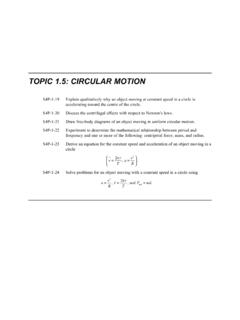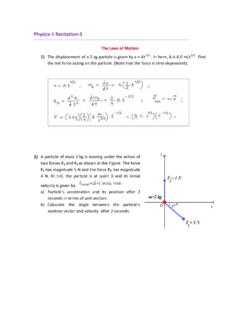Transcription of The Importance of Media in the Classroom
1 8/25/03 3:47 PM Page 1. 1. The Importance of Media in the Classroom A s teachers, we have a wealth of information from which to choose for our classrooms. We can now bring history into the Classroom through pictures, music, and other visuals to a degree never before possible. We can communicate with students from other countries, and we can take classes from teachers we have never met in places we have never been. We can apply the physics from the Classroom to simulations avail- able to us through the Internet, and we can develop projects across grade levels and campuses. Students are no longer lim- ited by the walls of a Classroom or the knowledge of a single textbook. The world is available to most classrooms, even when students do not have their own computers. We can bring the Media into the Classroom through visuals, sounds, smells, and tastes. Because our brains rely heavily on stimulus from the outside for learning, this is just one of the reasons that teaching with Media is brain friendly.
2 In addition, we should bring technology to the Classroom because: 1. 8/25/03 3:47 PM Page 2. 2 Media and Technology n Technology is not limited by the Classroom walls. n Technology does not know or care what the student's socioeconomic status may be, and thus helps to level the playing field for these students. n Technology provides an equal opportunity for every- one to learn. n Technology is more in tune with the way our students learn today. n Technology is so much a part of the real world that to limit its use in the Classroom is to limit our students'. ability to compete in the world. WHY Media IS BRAIN FRIENDLY. Most researchers define brain-compatible learning as learning that occurs: n Using modalities that are most comfortable for the learner. For example, most learners are either visual or kinesthetic, thus a brain-friendly environment will lean heavily on teaching methods that include visuals, mod- els, or hands-on activities.
3 N In an environment that is positive and friendly and incorporates high expectations for everyone. n In a Classroom that utilizes research-based methods for teaching and learning. n In a Classroom that provides a variety of opportunities for learning. n In a Classroom that is flexible in terms of time, resources, and structures. For example, if something is not work- ing, the problem is identified, diagnosed, and fixed rather than just moving on. If students need more time to learn, more time is given rather than sticking to a fixed timetable, regardless of the quality of the learning. n In a Classroom where quality is important and students are given rubrics or matrices that tell them in advance what is expected. 8/25/03 3:47 PM Page 3. The Importance of Media in the Classroom 3. n In a Classroom where standards are used and where students know the expectations. The students are pro- vided opportunities to review their work in terms of given standards so that they know at all times where they stand.
4 N When specific feedback is given consistently and frequently. Just saying Good job is not enough. We are being encouraged to use brain-based strategies in our classrooms; one of the best ways to do so is through the use of Media in the teaching/learning processes. In this chapter, we will examine several ways that using Media enhances the principles of brain-based learning. THE EFFECT OF Media ON STUDENT MODALITIES. As I have discussed in most of my books, about 98% of all incoming information to the brain comes through the senses. Add to that the fact that over 87% of the learners in the class- room prefer to learn by visual and tactile means, and you have a recipe for failure if the primary methods of teaching are auditory. In Growing Up Digital (1998), Don Tapscott said that this Net Generation watches much less television than did its parents. The television is not interactive, and this genera- tion prefers to be active participants in all that they do.
5 Tapscott cited a 1997 survey by Teenage Research Unlimited, in which 80% of the teenagers polled said it is in to be online right up there with dating and partying. THE EFFECT OF Media ON MOTIVATION. According to Jensen (1997), interactive abstract learning that includes the use of various Media , such as CD-ROMs, the Internet, distance learning, or virtual reality, utilizes the cate- gorical memory and requires little intrinsic motivation. Although traditional forms of education receive the greatest 8/25/03 3:47 PM Page 4. 4 Media and Technology amount of the education dollars, they require a great deal of intrinsic motivation to be effective. Students must struggle to make the traditional type of learning work, since it is outside the context of its meaning. In addition, students from inner-city poverty learn in con- text usually from stories and to require them to learn all day in an environment that is not brain friendly for them helps to set them up for failure.
6 Similarly, English language learners need visual stimulus to help them to process and store the information that comes from words. They often do not have the language acquisition skills in English to store a great deal of dialogue in a way that can be easily retrieved when needed. Semantic information ( , words, facts, and names) is stored in the semantic memory system the least effective of the memory systems of the brain. In order to have meaning to the learner in terms of retrieval, semantic information must have a connector. Try memorizing a long list of words and you will see what I mean. The brain was not created for memorizing meaningless infor- mation. If you try to memorize a long list of words, you will probably find yourself devising a plan to help you, such as creating acronyms or developing a story around the words to help you memorize them. You are giving the words a context or connection to help you remember.
7 Contextual learning is stored in the episodic memory system, which is much better at remembering. Remember, the next time you require students to learn a list of items, that the more context you can provide, the stronger the recall. Using Media in the form of auditory or visual stimulus can help you do this. THE EFFECT OF Media . ON BEHAVIOR MANAGEMENT. If you have read What Every Teacher Should Know About Classroom Management and Discipline (Tileston, 2004a), you know that most of the discipline problems in the Classroom are caused by such factors as boredom, not understanding the 9/13/03 12:10 PM Page 5. The Importance of Media in the Classroom 5. relevance of the information, and incorrect modalities for learning. You also know that over 87% of the students in any given Classroom are visual learners. Students who enter our classrooms have been a part of a multimedia world since birth. Students today were able to insert videos or DVDs of children's programs into the appro- priate devices for viewing from the time that they were three years old.
8 If they want to know something, they search the Internet. It should not be surprising to us that these same students have difficulty sitting all day in classrooms that rely on low technology, such as overheads, whiteboards, lectures, and note taking, as the major sources of information gather- ing. For the majority of students, who are visual, just hearing the information is not enough; they need to see it and to expe- rience it. We lament the fact that students do so poorly in mathematics and yet we teach this subject primarily by lecture and homework ( , drill and practice). If we can find ways to help these students see how the math works and how it is applied to the real world, we are more likely to have better math students. Media can help us get there quickly. THE EFFECT OF Media ON. REACHING HIGHER LEVELS OF THOUGHT. There are so many great Websites that encourage and teach higher-level thinking that we do an injustice to our students if we do not lead them there.
9 Using Media is the key to moving students to higher-level thinking. Our students are already familiar with using the Internet and many of the software programs required to reach such higher-level thinking skills as creativity, problem solving, comparison and contrast, and evaluation. We need to lead them to the best of the best in term of Media and to provide feedback as they work. Real- world applications, such as the physics software that explores how to design amusement park rides utilizing g-forces with- out damaging the body , are exciting and fun, but they also lead students into problem solving and decision making. 8/25/03 3:47 PM Page 6. 6 Media and Technology In a study by Harold Wenglinsky (1998) on the impact of Media on learning mathematics among fourth and eighth graders, it was concluded that when computers are used to perform tasks applying higher-order concepts and when teachers are proficient in directing students toward productive uses, computers are associated with significant learning gains.
10 THE EFFECT OF Media ON. REAL-WORLD APPLICATIONS. We know that motivation to learn and to complete tasks is directly related to the student's perception of the relevance of the learning. All learning seems to begin in the self-system of the brain. This is the system that decides whether or not to engage in the learning. If the task is judged important, if the probability of success is high, and a positive affect is gener- ated or associated with the task, the individual will be motivated to engage in the new task (Marzano, Pickering, &. Pollock, 2001). In What Every Teacher Should Know About Learning, Memory, and the Brain (Tileston, 2004c), I note that one critical question asked by the brain in determining to what to pay attention to is whether the information is important: Information can be important to the teacher and to the students, but unless the student believes the information is important, the self-system will not view it as important.


















